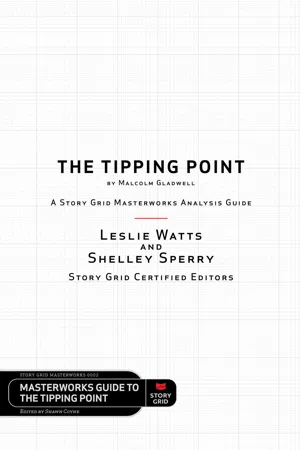
The Tipping Point by Malcolm Gladwell - A Story Grid Masterwork Analysis Guide
- English
- ePUB (mobile friendly)
- Available on iOS & Android
The Tipping Point by Malcolm Gladwell - A Story Grid Masterwork Analysis Guide
About this book
Is it possible to write a nonfiction book that changes minds or even changes the world?
The Tipping Point by Malcolm Gladwell sold 1.7 million copies in its first year of release, and today remains a perennial bestseller.
What made it go viral?
What made it stick?
On the 20th anniversary of The Tipping Point’s publication, two Story Grid editors decided to dissect Gladwell’s masterwork to find out what made it a cultural touchstone.
Leslie Watts and Shelley Sperry analyze the macro structure of the book and each individual scene to understand how Gladwell uses scientific evidence, charming anecdotes, and compelling characters to bring complex ideas to life. The breakdown of each scene reveals the essential questions Gladwell asks and answers and....
This Story Grid Masterwork Guide is a unique tool—a deep dive into the mind of a master storyteller designed to give you the tools and confidence to set off on an intellectual adventure and write a book that will transform your readers and stay on bookstore shelves for years to come.
Frequently asked questions
- Essential is ideal for learners and professionals who enjoy exploring a wide range of subjects. Access the Essential Library with 800,000+ trusted titles and best-sellers across business, personal growth, and the humanities. Includes unlimited reading time and Standard Read Aloud voice.
- Complete: Perfect for advanced learners and researchers needing full, unrestricted access. Unlock 1.4M+ books across hundreds of subjects, including academic and specialized titles. The Complete Plan also includes advanced features like Premium Read Aloud and Research Assistant.
Please note we cannot support devices running on iOS 13 and Android 7 or earlier. Learn more about using the app.
Information
Scene Analysis:
Middle Build
Chapter 1 - The Three Rules of Epidemics
Scene 5
INQUIRY EVENT
THE FIVE COMMANDMENTS OF STORYTELLING
NOTES
- In this scene, Gladwell introduces the three rules of Tipping Points in the context of the Baltimore syphilis epidemic in the mid-1990s. In the next three scenes, he shows how each rule operates in the context of disease epidemics (e.g., the flu, AIDS, syphilis, and gonorrhea) and then offers examples of how each rule works in social epidemics too.
- Gladwell provides commentary on the meaning of the events he is describing. Some findings or conclusions are obvious or interesting, strange or surprising or not, and may also be complicated, shocking, or chilling. This seems to be a subtle form of persuasion (or Pathos that is derived from the Ethos Gladwell has already established). If statement X is obvious to Gladwell, we’re not likely to challenge it. Are we? And are we more likely to trust the statement that is complicated because we assume Gladwell is smarter than we are and has done the intellectual heavy lifting? Probably.
Scene 6
INQUIRY EVENT
THE FIVE COMMANDMENTS OF STORYTELLING
Table of contents
- Cover
- Contents
- THE TRUTH IS
- WELCOME TO THE STORY GRID UNIVERSE. HERE'S HOW WE CONTEND WITH THOSE TRUTHS:
- Title Page
- Copyright
- BLANK
- Dedication
- Introduction
- Scene Analysis:
- Scene Analysis:
- About the Authors
- Notes